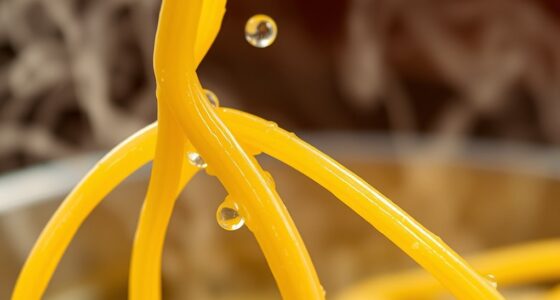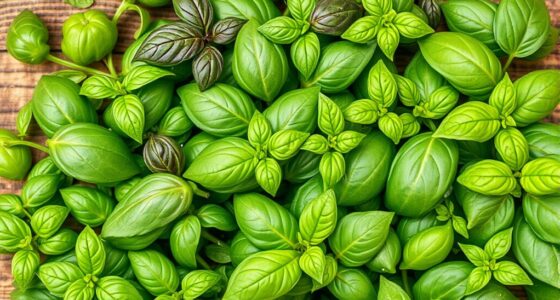Gelatin gives Italian desserts their smooth, shiny textures by forming a molecular network that traps water and sets the shape. It transforms simple ingredients into silky, firm confections like panna cotta and Bavarese. Understanding how gelatin works helps you appreciate its role in traditional recipes that date back centuries. If you want to discover more about how its science influences Italian sweets, keep exploring the fascinating details behind this versatile ingredient.
Key Takeaways
- Gelatin creates a firm, glossy texture by forming a molecular network that traps water in Italian desserts.
- It has been used historically in Italy since the Renaissance, evolving from medicinal jelly to sweet delicacies.
- Vegetarian alternatives like agar-agar, pectin, and carrageenan mimic gelatin’s gelling properties through similar molecular interactions.
- Understanding the science of molecular bonds helps in selecting the right gelling agent for different Italian desserts.
- Modern trends favor plant-based gels for ethical, health, and environmental reasons while maintaining traditional textures.

Have you ever wondered how Italian desserts achieve their smooth, glossy textures? The secret often lies in gelatin, a powerful ingredient that transforms simple ingredients into elegant, luscious treats. While gelatin is traditionally derived from animal collagen, many people seek vegetarian alternatives to enjoy these desserts without compromising their dietary choices. These alternatives include plant-based gels like agar-agar, pectin, and carrageenan, which mimic gelatin’s gelling properties. Understanding these vegetarian options not only broadens your culinary horizons but also highlights the evolving nature of traditional Italian recipes. Historically, gelatin’s use in Italy dates back centuries, where it was initially a luxury ingredient reserved for the aristocracy. Over time, as culinary techniques advanced, gelatin became more accessible, allowing skilled chefs to craft the iconic panna cotta, Bavarese, and other jellied desserts we love today. Its versatility and ability to create a silky, firm texture made it indispensable in Italian confectionery.
The historical origins of gelatin in Italian desserts reveal a fascinating journey. Originally, gelatin was imported from the Middle East, where it was used in medieval times for medicinal and culinary purposes. It wasn’t until the Renaissance that gelatin began to be incorporated into Italian desserts, evolving from a medicinal jelly to a sweet delicacy. As trade routes expanded, gelatin became more readily available, and Italian cooks started experimenting with it in their recipes. This period marked the beginning of a tradition that would see gelatin become a cornerstone of many classic Italian desserts. Today, the use of vegetarian alternatives has gained prominence, especially among those who prefer plant-based diets or seek to avoid animal products. Modern chefs often replace traditional gelatin with agar-agar, derived from red algae, which sets quickly and produces a similar glossy finish. Pectin, extracted from fruit, is another option, especially in fruit-based desserts, providing a natural, vegetarian-friendly way to achieve the desired texture. Additionally, understanding the molecular interactions involved in setting agents can help in selecting the best alternative for specific recipes.
The transition to vegetarian alternatives isn’t just about dietary restrictions; it also reflects a broader shift towards sustainable and ethical eating practices. Despite these changes, the core science remains the same: gelatin and its substitutes form a network of molecules that trap water, creating the characteristic firm yet tender consistency that defines many Italian desserts. Whether you’re making a classic panna cotta or experimenting with plant-based gels, understanding the origins and alternatives of gelatin allows you to craft authentic Italian desserts that are both delicious and aligned with your values. This knowledge empowers you to innovate while respecting the rich history behind these beloved confections.
Frequently Asked Questions
How Does Gelatin Affect the Texture of Italian Desserts?
You’ll notice that gelatin’s gelling properties markedly influence Italian desserts’ textures. When you add gelatin, it creates a smooth, firm, yet tender consistency that enhances the dessert’s overall mouthfeel. It helps set the mixture, giving it a pleasant, cohesive structure. By understanding how gelatin works, you can better control the dessert’s texture, making it more enjoyable and visually appealing through effective dessert texture enhancement.
What Are the Best Gelatin Alternatives for Italian Recipes?
Imagine a silky, firm texture that melts in your mouth, without relying on traditional ingredients. You can achieve this using vegan substitutes like agar-agar or carrageenan, which are natural thickeners derived from seaweed. These options work beautifully in Italian recipes, offering a plant-based way to set desserts while maintaining that luscious consistency. Experimenting with these alternatives allows you to create delicious, cruelty-free treats that captivate your senses.
How Long Does Gelatin Take to Set in Traditional Italian Desserts?
You might wonder how long gelatin takes to set in Italian desserts. Typically, the gelatin setting time varies between 2 to 4 hours, depending on the dessert’s thickness and ingredients. For best results, refrigerate your dessert for at least this duration, ensuring proper dessert refrigeration. Keep in mind, thicker desserts may require longer refrigeration to achieve the desired firmness, so plan accordingly for a perfect presentation.
Can Gelatin Be Used in Gluten-Free Italian Desserts?
This question is so important, it could change your dessert game forever! Yes, you can use gelatin in gluten-free Italian desserts, but if you’re seeking vegetarian options, plant-based thickeners are your best friends. These thickeners, like agar-agar or pectin, work perfectly as alternatives, offering a plant-based, gluten-free solution that keeps your desserts delicious and satisfying. Embrace these options to create stunning, allergen-friendly Italian treats!
What Is the History of Gelatin in Italian Culinary Traditions?
You might find it fascinating that gelatin’s history in Italian culinary traditions has deep roots, reflecting its historical influence from ancient times. It gained cultural significance through its use in elaborate desserts like panna cotta and fruit aspics, showcasing Italy’s rich gastronomic heritage. Over centuries, gelatin became a symbol of sophistication in desserts, blending local ingredients with imported techniques, and evolving into a staple that highlights Italy’s culinary artistry today.
Conclusion
Now that you understand how gelatin transforms Italian desserts, think of it as the silent artist behind each masterpiece. It’s the invisible hand that shapes silky panna cotta and delicate semifreddo, turning liquid into a beautiful, wobbly wonder. With this knowledge, you’re ready to craft your own culinary art. So, embrace gelatin’s magic — it’s the brush that brings your sweet creations to life, making every bite a delightful masterpiece.









